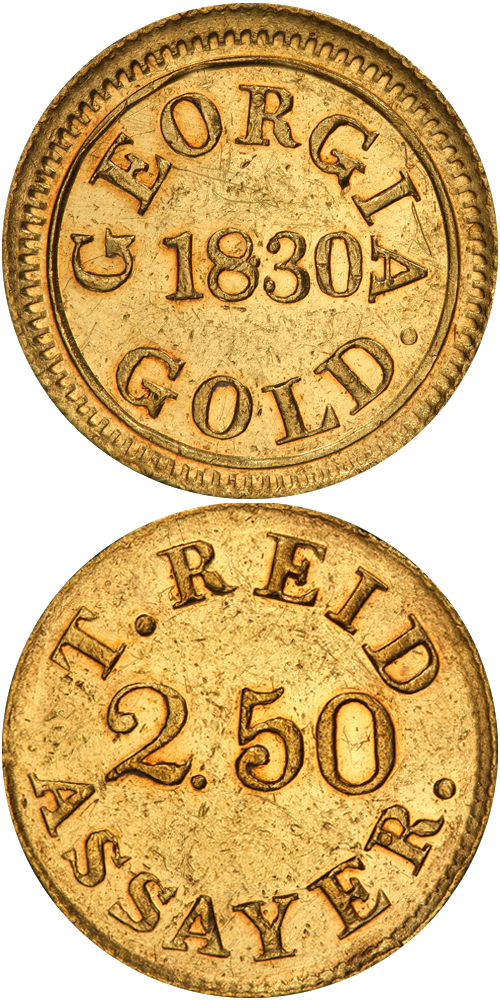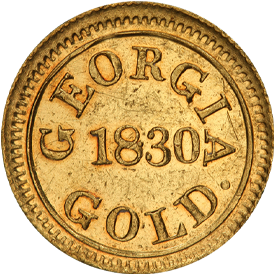Templeton Reid's private Georgia Mint operated for only three months. Coinage was effected during part of July, all of August and September, and part of October in 1830. Many of his coins were subsequently melted by the United States Mint, accounting in part for their extreme rarity today. Dexter C. Seymour, who studied the series in depth and published several monographs on the results of his research on the Reid coinage, has suggested there was a total production of about 1,600 coins. This limited figure comprises approximately 1,000 quarter eagles, 300 half eagles and 250 eagles.
During the 1820s gold was discovered in several different locations in Georgia. Templeton Reid was an engraver who engaged in the manufacture of watches, guns and other practical items. He sought to fill a commercial need by converting gold dust, which at the time was traded by weight in the area, into coins. In July 1830 an article in a local newspaper, the Southern Recorder, described Reid's operation and commented that by the 24th of the month (the date the article appeared), approximately $1,500 worth of gold had already been stamped into the denominations of $2.50, $5 and $10. Reid informed the newspaper that his coins would be acceptable at the Mint and at local banks at the face value of each piece.
Less than a month later a disgruntled citizen, who styled himself anonymously as "No Assayer," wrote a letter to another newspaper which was published in the issue dated August 16th. "No Assayer" claimed he had sent a Reid $10 piece to the Mint in Philadelphia only to learn that the actual value was only $9.38. In an era when the public was very concerned with intrinsic value, this represented a unconscionably high profit for the minter. Reid, it seems, did not intentionally produce his coins with low value; rather, he was apparently unfamiliar with the true metallic content of the pieces and considered the gold to be nearly pure. This was not the case as the gold dust he used contained silver, tin and other metals as impurities. On September 16th the Georgia Courier observed editorially that Reid "is making about $15,000 per annum. This is better business than gold digging. "
Criticism of Reid's operation and coinage continued in the Georgia newspapers, with "No Asssayer" further condemning his issues and giving his opinion that Templeton Reid "cares not for the Constitution of the United States with the value of gold at the proper place of coining, the Mint. "
This publicity put an effective end to the short-lived Templeton Reid coinage. At the time the coins were produced, 1830, there was no numismatic interest in them among the few coin collectors in the United States. Accordingly, the survival of Templeton Reid coins today is a matter of chance. Most of the approximately 1,600 issues met various fates; primarily they were melted for conversion to bullion or to United States coins. Today Templeton Reid coins of each of the three denominations are exceedingly rare. Often a long span of years will intervene between each offer of one.







